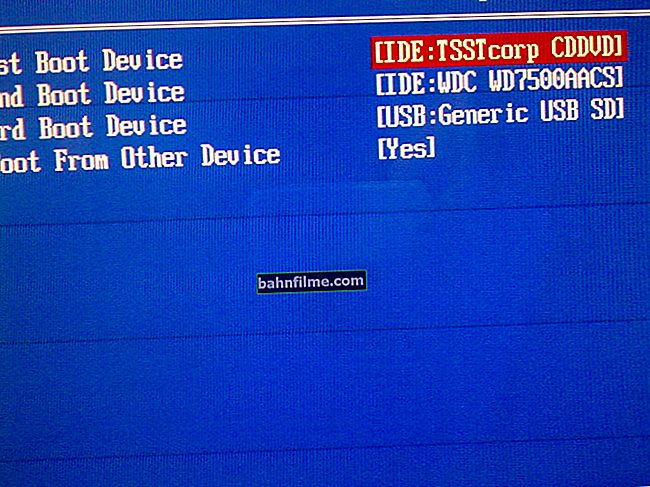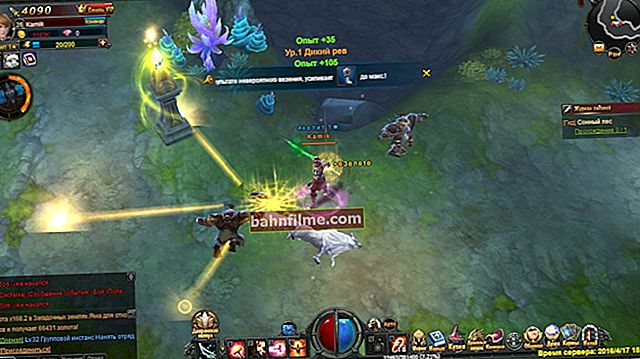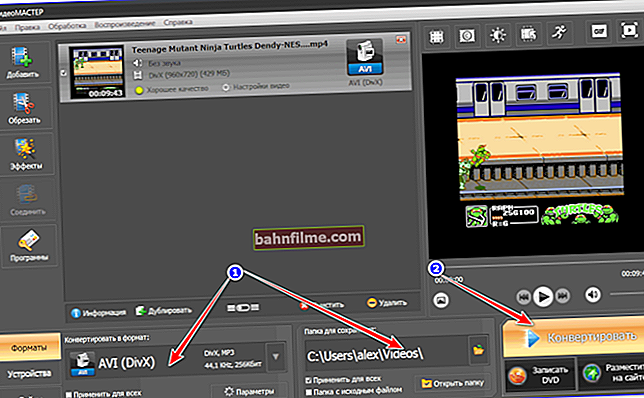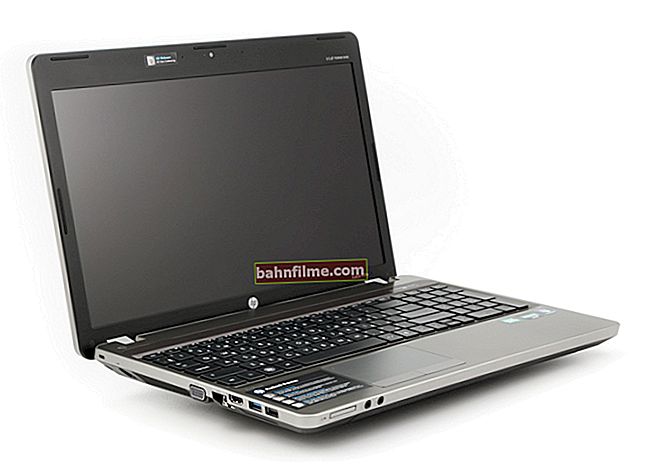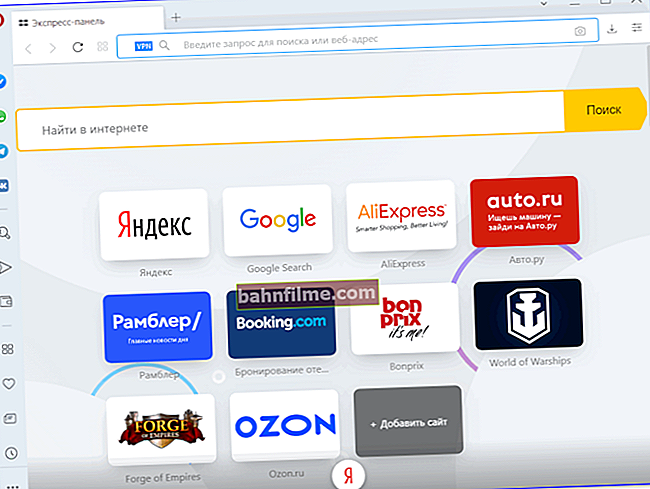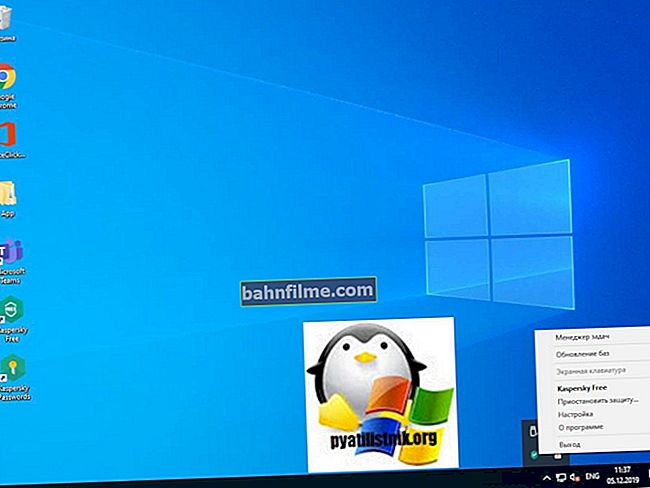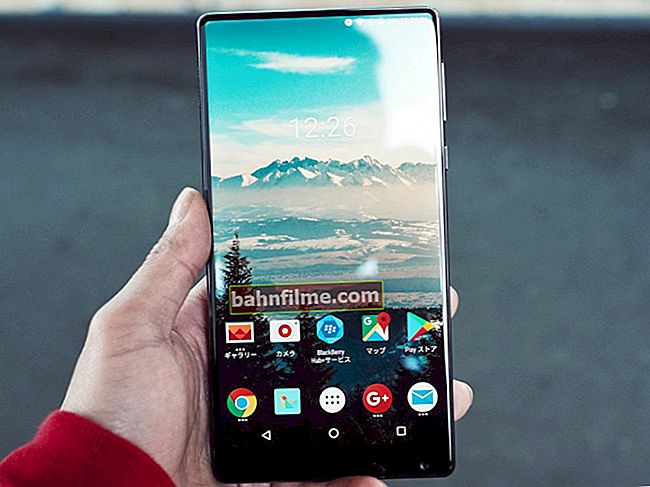
- Hello!
- Hello...
- You can't tell me, I've been fiddling with the Windows installation for an hour now and I just can't get the BIOS to boot from the USB flash drive - he just doesn't see it !!!
- Well ... try to remove the invisibility hat from her 😊...
I recently had such a dialogue with one of my acquaintances, we, of course, eliminated the problem of invisibility, but the conversation was long  .
.
In general, most often this problem is encountered when reinstalling Windows, and sometimes it is far from easy to solve it. In fact, there are many reasons for invisibility, but I will highlight the most basic ones in this article. By going through them, I think you can easily configure and install a new Windows ...
*
The main reasons why the BIOS does not see the bootable USB flash drive
1) Incorrectly recorded bootable USB flash drive with Windows
This is perhaps the most common reason. Many users create bootable USB drives in one scenario: they simply copy files from a Windows CD / DVD to a USB flash drive. At the same time, some users say that everything works ...
Perhaps this is true, but it is not entirely correct. To create bootable flash drives, it is best to use special utilities (especially since there are quite a few of them!).
I recommend trying the following utilities: Ultra ISO, Rufus, WinSetupFromUSB, WintoFlash, Windows 7 usb dvd download tool (utility from Microsoft).
👉 Remark!

A complete list of utilities for creating bootable USB drives - you can see here
Example: how to properly write a bootable USB flash drive in Rufus
1) First step: insert the USB flash drive into the USB port of the computer. We copy all important data from it to the hard disk (if any). Then it can be formatted (optional).
2) Second step: the Rufus program must be run as administrator (for this, it will be enough to right-click on the executable file "rufus.exe", select it in the context menu that appears);
3) Now go to the Rufus settings (screen below + explanations to it for each item):
- count "Device" : select our USB flash drive for recording;
- Under number 2 the screenshot shows a button that sets an ISO image file with Windows OS, intended for writing to a USB flash drive (just specify it);
- count "Partition scheme" : "GPT for computers with UEFI" (if you have a new PC / laptop, read more about it here);
- count "File system" : choose FAT 32 (usually, it is installed by default);
- The last button ("Start") is to start the recording process.

Rufus - creating a USB flash drive for UEFI (GPT)
Before recording, Rufus, by the way, will warn you that all data on the flash drive will be deleted. If you didn't manage to save something - save it, after formatting the flash drive - it will not be so easy to restore the data ...
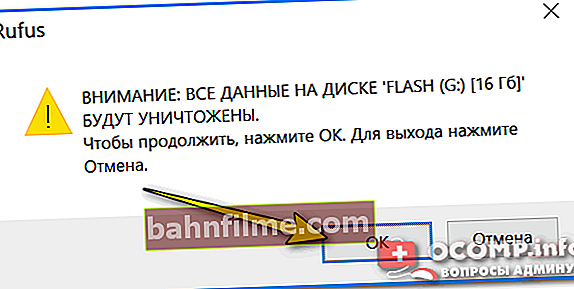
Rufus warning
That's all, in fact, a USB flash drive recorded in this way should work 100% and be visible, in almost any modern BIOS version (UEFI) ...
*
2) Boot priority is not set in BIOS (UEFI)
So that you can boot from a flash drive and start installing Windows, you need to properly configure the BIOS / UEFI (and this always has difficulties, especially for novice users  ).
).
First you need to enter the BIOS settings.
*
👉 Help!

In order not to repeat myself, I give a link to my previous article, which describes in detail how to enter the BIOS, which buttons and from which manufacturers to press.
*
The BIOS has a boot priority (sometimes called a boot queue): for example, it first checks a floppy disk for boot records, if not, then the hard disk, then the CD drive, etc. As soon as boot records are found on some media, the computer will boot from it.
Our task is to change the boot priority so that first of all the computer checks the boot records on the USB flash drive, and then on the hard drive.
To do this, the BIOS / UEFI has a BOOT section. For example, the screenshot below illustrates the following download priority:
- CD / DVD discs;
- HDD.
Naturally, with this setting - no matter how much you insert a USB flash drive into the USB port - the computer will not see it!

BIOS will not see the flash drive
By changing the boot priority to your own - that is, putting USB in the first place, instead of a CD / DVD drive, you can boot from a USB flash drive (do not forget to save the settings - F10 key, or Exit: Save and Exit) .

The BIOS will now see the USB flash drive

Boot Section - Boot Configuration (Example UEFI Settings)
I also want to note: various BIOS versions may differ in menus, sections, and generally in appearance.
The screenshot below shows the settings for "Award Software Advanced BIOS Features" - in it, in order to boot from a USB flash drive, you need to opposite the item " First Boot Device "(note: first boot device) - set USB-HDD (this is the flash drive). Then save the settings (F10 key).

BIOS setup for booting from a USB flash drive
In the BIOS, laptops usually always have a section BOOT ... Having entered it, you also need to put the device in the first place: USB Storage Device, USB-HDD, USB device, etc. (depending on your laptop model, BIOS version).

Dell Laptop - Boot Section
*
3) Secure Boot is not disabled in BIOS (or wrong flash drive)
Secure Boot Is a relatively new feature that is designed to prevent unwanted software from running when the computer is turned on. All modern laptops and computers have this option (until about 2013 - it almost never met). Secure Boot support Windows 8, 8.1, 10.
There are two solutions:
- Create a UEFI flash drive, thus you do not have to disable Secure Boot in the BIOS. How to create such a bootable USB flash drive is described here;
- Disable Secure Boot in BIOS and install Windows (by the way, for example Windows 7 does not support this function at all).
To disable Secure Boot - you need to enter the BIOS and open the BOOT section (in most cases this is the case, but sometimes this function is contained in the "Advanced" section).
As a rule, in BOOT, you need to change the following (for example, a Dell laptop):
- Boot List Option: change UEFI to Legacy;
- Fast Boot: Change Enabled to Disabled (ie disable "fast" boot);
- don't forget to change the boot priority (see example screenshot below).

Secure Boot enabled / disabled
*
4) USB 3.0 or USB 2.0
On new computers and laptops, some of the USB ports are made in the old "format" - USB 2.0, the other in the new - USB 3.0. When copying files to a USB flash drive, there is no big difference which USB to use (well, except for the data transfer speed).
But when installing Windows - the choice of USB port plays a key role! The point is, Windows 7 does not support USB 3.0 installations! Those. by inserting a bootable USB flash drive into such a port - you will not be able to install Windows 7!
How to tell a USB 3.0 port from a USB 2.0 port
Everything is very simple - USB 3.0 are marked in blue (or blue): moreover, both plugs and ports are marked. Pay attention to the two photos below - everything is clear from them ...

USB 2.0 and USB3.0 (marked in blue)

Another case in point: USB 2.0 and USB3.0
Note: Windows 8, 10 - can be installed using USB 3.0 (USB 3.1) ports.
*
5) Is the USB port working ...
Without going far from the USB ports, I would also like to dwell on the following point: does the USB port work at all? If you have an "old" Windows OS installed, and it still "somehow" works (and in most cases it does) - try to boot your computer and check the port.
👉 To help!

USB ports are not working, what should I do?
*
I recommend paying special attention to the USB ports located on the front panel of the system unit, on keyboards, adapters, etc.
Often, the reason lies precisely in this: for example, one friend of mine could not install Windows, because he connected a bootable USB flash drive to the USB ports on the keyboard, and these ports began to work only after Windows was booted.

USB ports on keyboard
Therefore, a simple advice: try connecting the flash drive to another USB port (preferably USB 2.0), on the back of the system unit.
*
6) "Brutal" collection with Windows
There is not much to comment on here - any assemblies can be the cause of anything 😎 (I, of course, exaggerate somewhat, but still ...).
In general, I recommend using a licensed version of Windows OS - this way you will not only waste less time on debriefing with the installation of the OS, but also further, in the process of work, settings, etc.
👉 Help!
How to download an ISO image from Windows 10 [officially and legally]
*
7) "Old" PC, does not support booting from USB sticks
If you have an old computer, then it is quite possible that it may not support the option of booting from USB flash drives at all (however, in this case, you will not be able to configure the BIOS - it simply will not have an item for selecting USB-Flash Drive ( i.e. it will be obvious)).
If you have an old PC and want to install from a USB stick, there are several ways:
- update the BIOS version to a newer one that supports booting from a USB flash drive (If, of course, there is such an update on the website of your hardware manufacturer. Important! Updating the BIOS may cause the PC to malfunction!);
- use a boot manager like Plop Boot Manager. In this case, you will first boot into this manager (by the way, you can burn it to a CD), and then select boot from a USB device in it and continue with the installation.

Plop Boot Manager
*
PS
Perhaps the bootable flash drive is not visible not only when the computer boots, but in general: on any PC, and not in any Windows? You can learn more about this in this post ...
*
And this is where I finish the article, good luck!
✌
Correction: 03/29/2020
First publication: 10.12.2016
